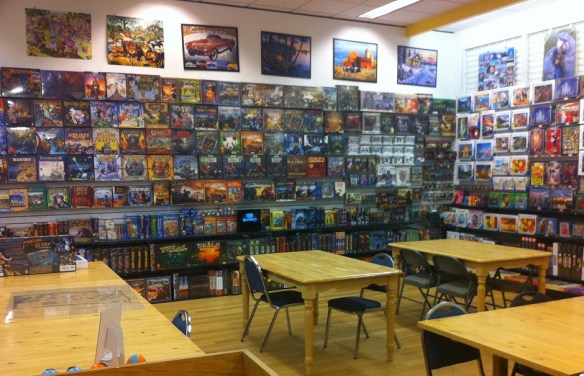
- Game Title: One Night Ultimate Werewolf
- Release Date: 2014
- Number of Players: 3-10
- Average Game Time: 10 minutes
- Game Publisher: Bezier Games
- Website: http://beziergames.com/products/one-night-ultimate-werewolf
- Game Designer: Ted Alspach, Akihisha Okui
- Expansions/Alternates: Yes
- Available in Stores: Yes
This board game of the week is thanks to my girlfriend, Mary, and a group of our friends. I had heard a lot about “that Werewolf game” from them for a few weeks until I finally got a chance to try it out myself. The result was a group of 7 people in their mid-20’s arguing about how I was obviously a werewolf, even though I continuously told them that I wasn’t. Lack of trust aside, the game is based around the childhood game “Mafia” and is a fun and engaging way to spend your time. The game is very fast-paced, so the expectation would be to play the game at least 2-3 times in a row in a single sitting.

One Night Ultimate Werewolf starts with everyone choosing what “roles” they want to include in the upcoming game. The game comes with 16 different roles that all have different effects during the game. Every game must have at least 2 werewolves, 1 seer, 1 robber, 1 troublemaker, and one villager. Depending on the number of players in the game, additional roles are added before the game starts (must have three more roles than the number of players in any game). Once the role cards are chosen, they are shuffled and one card is given to each player and the remaining three are left face down with nobody viewing them. After you check your role, the “night” phase of the game begins. This is where the Mafia style of game mechanic comes into play- during this phase, everybody closes his/her eyes, and players with certain roles “wake up” (open their eyes) at specific times to complete tasks related to their roles. These actions change depending on which roles were picked, but the order for when everyone opens and closes his/her eyes remains the same no matter what. Once all of the roles have completed the necessary tasks, the night phase ends and it switches to the “day” phase.
Once it becomes the day phase, everyone openly discusses who they believe is the werewolf. The werewolves then try and divert the blame from themselves by accusing others, while the villagers are all trying to determine who the werewolves are. You can say anything you want during this time, but you cannot show your role to another player- they will have to take you at your word. The day phase usually only lasts about 5-10 minutes and once time is up, everyone votes for who they believe the two werewolves are (this is done by pointing, either at a person or at the face-down cards in the center if you think nobody is a werewolf). The two people with the most votes are then accused of being the werewolf and must show their card. If one of them was the Werewolf, then the villagers win. If neither of them was the werewolf, the werewolves win.

There is, in fact, an app for that
This description of the game is very basic and glosses over details of how the different roles affect each other. There are certain roles that switch role cards between players, look at other player’s roles, or even take on the role of another card that you view. After the night phase, you could find yourself in a situation where you have no idea what role you currently have in comparison to when the game began. This makes your strategy and the voting process all the more complicated, and certainly adds to the intrigue of the final results. Another big factor in the game is the speed- it is supposed to be a very quick game which only allows for a specific amount of time to discuss and vote. In order to help with the timing portion of the game, I highly recommend someone from your group download the free app that goes with the game. This app not only keeps time for you throughout the whole game, but also announces the phases of opening and closing eyes during the night shift according to the roles your group is using.
One Night Ultimate Werewolf is a difficult game for me to review- on the one hand, its gameplay and fast-paced style are quite engaging. On the other hand, there are some flaws in the way the character roles are structured, and the time limit feels constricting at times. I like the fact that you can choose what roles are involved in every game, but I am not a huge fan of the idea that your role can change without you knowing it. The fun of the game is certainly apparent- bluffing and trying to trick your friends into thinking you are one thing when you’re actually another is a staple of many board/card games. Still, the concerns should definitely be noted; knowing what the game is about is important, and will make it more fun because you’re going in with a full understanding of what to expect.

I feel like you have to be in a very particular mood if you want to play this game- it is certainly a lot of fun when you get a group of people involved, and the positives certainly outweigh the negatives, but I would recommend understanding the rules and formulating a strategy before you dive headfirst into the game.
Jack’s Rating: 3.5/5 stars










 to King of Tokyo (energy, heal, and attack) they added new sides to the dice for different effects. Instead of numbers 1-3, the dice now have destruction, celebrity, and Ouch! sides which provide different effects.
to King of Tokyo (energy, heal, and attack) they added new sides to the dice for different effects. Instead of numbers 1-3, the dice now have destruction, celebrity, and Ouch! sides which provide different effects.

 victory points). Once the building is destroyed, that building tile is flipped over to become an enemy unit. Enemy units attack you when you roll an Ouch! symbol, and can also be destroyed by destruction symbols for varying effects.
victory points). Once the building is destroyed, that building tile is flipped over to become an enemy unit. Enemy units attack you when you roll an Ouch! symbol, and can also be destroyed by destruction symbols for varying effects. someone is new to board gaming and better for more casual game nights. King of New York’s additions make the game more complex, which makes the game better for high-strategy groups and a more intense gaming experience. King of New York should not replace King of Tokyo in your collection, and in fact they both complement each other quite well. Because of this, I feel that King of New York deserves the same rating as King of Tokyo did: a fun, challenging, and engaging game with beautiful artwork that is great for your collection.
someone is new to board gaming and better for more casual game nights. King of New York’s additions make the game more complex, which makes the game better for high-strategy groups and a more intense gaming experience. King of New York should not replace King of Tokyo in your collection, and in fact they both complement each other quite well. Because of this, I feel that King of New York deserves the same rating as King of Tokyo did: a fun, challenging, and engaging game with beautiful artwork that is great for your collection.